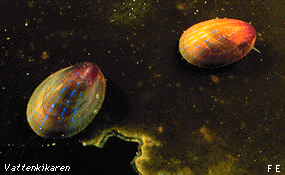 |
|
PesticideYoung plants secrete mucus and other substances that smell and taste bad. Animals and algae therefore have difficulty attaching to the slippery surfaces. The alga produces a chemical pesticide to keep intruders at bay.
On the other hand, older plants quite often have other plants
growing on them, mostly sea-mats,
hydroids
and fine threaded algae. Animals and algae shade the plants and make it
more difficult to absorb sunlight for photosynthesis. It is possible to
say that it starves as it cannot absorb enough light to produce energy rich
compounds.
Blown asunder
Sugar kelp can normally be as old as 3 years.
They usually die during a storm when the waves have ripped the plant loose
from its foundation. If animals, like the kelp
limpet or sea-urchin
have eaten parts of the root system or stalk, it easily torn loose in the
waves. Even bacteria
can feed on older plants. Bacteria can be eaten by small animals, and
in turn became food for larger animals.

Kelp limpet feeding on a sugar kelp leaf.
 |
Page 4 of 9 |
 |
|



